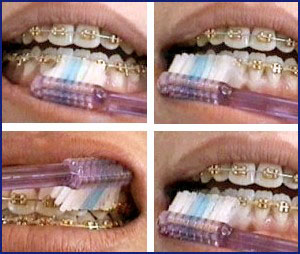
During orthodontic treatment it is very important to brush and floss after every meal in order to keep your gums and teeth healthy throughout treatment.
All patients will be shown proper techniques for maintaining the appliances, teeth and tissues. Proper hygiene habits are of CRITICAL importance. We insist that the mouth be in a healthy state before treatment is started, and it is vitally important that it be kept that way throughout the entire treatment period.
Poor oral hygiene can result in tooth decay and swollen and bleeding gums. Irreversible decalcification of the tooth enamel (white chalky markings on the teeth) is a common consequence of poor hygiene and results in an unsightly appearance. Failure to maintain a high level of oral hygiene compromises our ability to treat a case properly and may even lead to the termination of treatment.
If you need additional help choosing the right brushing and flossing supplies, or with your technique please do not hesitate to ask us.

Brush your teeth with either a manual or electric toothbrush; there is evidence that electric toothbrushes improve plaque removal but the bristles tend to wear quicker. Start on the outside of the upper back teeth. Brush using a circular motion with the head of the brush angulated between the gum and the braces. Brush carefully all the way around, ten circles in each spot before moving on. Do the same on the inner surfaces of the upper teeth and then scrub the chewing surfaces last. Repeat on the lower teeth. Water Pik and other oral irrigating devices work well to remove food debris, but are not a replacement for brushing and flossing.

Insert Floss behind archwire. Gently clean sides of teeth and under gums with an up-and-down motion. Floss between all teeth once a day.